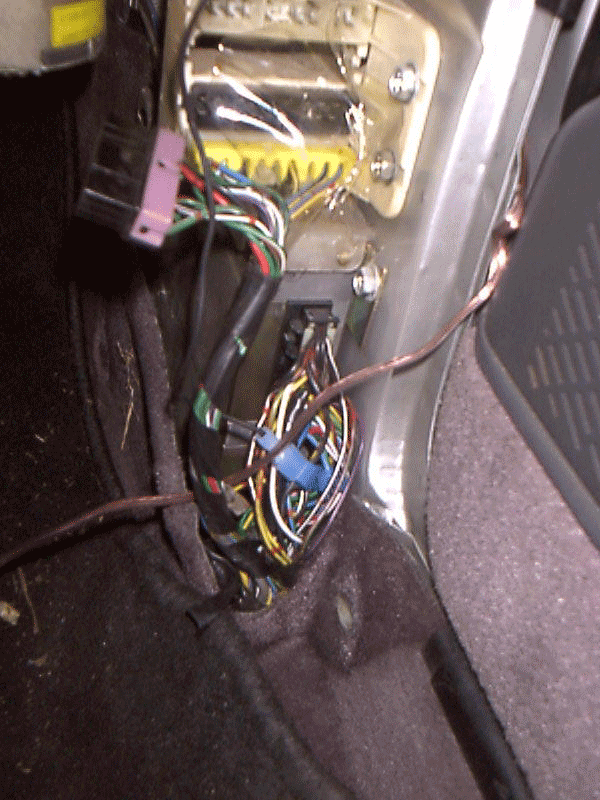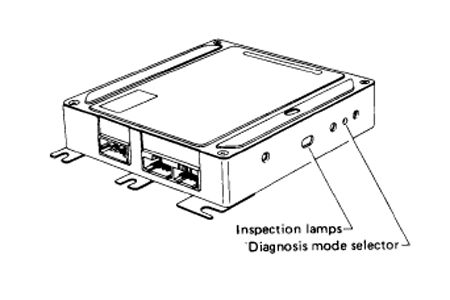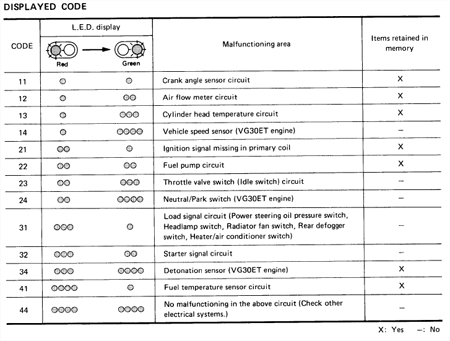Z31 ECU Diagnostics
ECU Self-Diagnostic Mode
The ECU has a self-diagnostic mode which will allow you to read fault codes for major sensors.
The self-diagnostic system determines malfunctions of signals which provide data to the ECU. The malfunctions may not be only E.C.C.S component malfunctions, but may also be poor contact of the connectors, shorted or open circuit of the harnesses, and malfunctions of the transit relays and diodes.
Some malfunctions are stored in the ECU and others are not. A malfunction is displayed by the red and green LEDs which are located in the control unit. Self diagnosis is performed when the self-diagnosis selector is in the ON position.
The ECU is located in the right side of the passenger foot well behind the kick panel. The image below shows the location:

*WARNING* - Do this diagnosis/mods at your own risk. We Are not responsable for any issues of your own doing.
1984-1987 Model Diagnosis
-
Unhook the ECU from its bracket in the right side of the passenger footwell (but leave it plugged into the ECU loom)
and locate the mode selector (a small screw on one side).

- Turn the ignition ON – the red and green LEDs viewed through the side window should be lit.
-
Turn the mode selector screw clockwise. The LEDs will begin to flash:
- Red LED = counts the "tens".
- Green LED = counts the "ones".
- Example: 1 red flash + 3 green flashes = Code 13.
- Write down each code displayed. They will repeat in sequence if you miss one.
- Depress and release the accelerator pedal fully once.
- Shift the transmission selector through all gears, then return to neutral.
- Start the engine if possible.
- Drive forward at least 6 mph to allow the ECU to complete checks.
- Turn the air conditioning ON and OFF (if fitted).
-
If all is well:
- With working A/C – the ECU will show Code 44.
- Without A/C – the ECU will show Code 31.
1988-1989 Model Diagnosis
-
Unhook the ECU from its bracket on the left side of the passenger footwell (leave it plugged into the loom) and locate the mode selector (small screw on the ECU).

- Turn the ignition switch to the ON position. Turn the diagnostic mode selector fully clockwise until the LEDs flash, then back fully counterclockwise.
- When the ignition is turned OFF during diagnosis and turned back ON, the ECU will automatically return to Mode I.
- On California models, the Check Engine Light will illuminate in Mode I if the emission system malfunctions with the engine running.
- Mode II diagnoses fuel and emission control system malfunctions using the self-diagnostic codes.
- To start the test: Warm the engine to normal temperature. Turn the selector fully clockwise, wait for 3 flashes, then turn it fully counterclockwise. The ECU is now in Mode III (trouble code mode).
Trouble Code Chart
| Trouble Code | Circuit or System | Possible Cause |
|---|---|---|
| Code 11 (1 red, 1 green) | Crank Angle Sensor | Faulty sensor or open/short circuit |
| Code 12 (1 red, 2 green) | Air Flow Meter | Source or ground circuit open/shorted |
| Code 13 (1 red, 3 green) | CHTS (Cylinder Head Temp Sensor) | Sensor or ground circuit open/shorted |
| Code 14 (1 red, 4 green) | Vehicle Speed Sensor | Open circuit |
| Code 21 (2 red, 1 green) | Ignition Signal | No ignition signal during cranking/running |
| Code 22 (2 red, 2 green) | Fuel Pump Circuit | Open or shorted circuit |
| Code 23 (2 red, 3 green) | Idle Switch Circuit | Open circuit |
| Code 31 (3 red, 1 green) | ECU Control Unit | Input signal out of range, replace ECU |
| Code 32* (3 red, 2 green) | EGR Function | EGR control valve not operating |
| Code 33 (3 red, 3 green) | Exhaust Gas Sensor | Sensor circuit open |
| Code 34 (3 red, 4 green) | Detonation Sensor (Turbo) | Sensor open or shorted |
| Code 35* (3 red, 5 green) | Exhaust Gas Temp Circuit | Circuit open or shorted |
| Code 42 (4 red, 2 green) | Fuel Temperature Sensor ** | Sensor open or shorted |
| Code 43* (4 red, 3 green) | Throttle Sensor | Sensor open or shorted |
| Code 45* (4 red, 5 green) | Injector Leak | Leaking injector(s), check and replace |
| Code 55 (5 red, 5 green) | No Malfunction | Normal Operation |
- * California Models Only
- ** Code 41 for 1987 models






